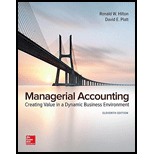
Define and give examples of inventory ordering, holding, and shortage costs.
Explain the meaning of the inventory ordering, holding and shortage costs and give examples.
Explanation of Solution
Merchandise Inventory: Merchandise is the stock of goods bought by a wholesaler, or a retailer, or a trader, to be sold within a year. Merchandise Inventory is a current asset account which includes all the costs incurred to acquire merchandise, and process it further for sale.
Explain the meaning of the inventory ordering, holding and shortage costs and give examples as follows
Ordering costs: The cost of preparing, placing and receiving a purchase order is called as ordering costs. Examples: Clerical costs of preparing purchase orders, time spent to find the suppliers and transportation costs.
Holding costs: Holding cost is a manufacturing cost that is incurred while the inventory is kept on hand for some period of time. Examples: Warehouse expense, security cost, insurance expense, deterioration and theft costs.
Shortage costs: Shortage cost is a manufacturing cost that is incurred when the organization does not have material or finished goods on hand for the production process. Examples: Costs caused by disrupted production, lost sales, and loss on quantity discounts on purchases.
Want to see more full solutions like this?
Chapter III Solutions
Managerial Accounting: Creating Value in a Dynamic Business Environment
- 4 POINTSarrow_forwardSmith Corporation uses direct labor hours in its predetermined overhead rate. At the beginning of the year, the estimated direct labor hours were 24,500 hours, and the total estimated manufacturing overhead was $490,000. At the end of the year, actual direct labor hours for the year were 24,200 hours, and the actual manufacturing overhead for the year was $495,000. Overhead at the end of the year was: a. $16,500 overapplied b. $14,800 underapplied c. $11,000 underapplied d. $10,500 underappliedarrow_forwardThe Blue Jay Corporation has annual sales of $5,200, total debt of $1,500, total equity of $2,800, and a profit margin of 8 percent. What is the return on assets? a. 8.50 percent b. 10.55 percent c. 9.67 percent d. 7.89 percent e. 12.22 percent.Answer this questionarrow_forward
- Principles of Accounting Volume 1AccountingISBN:9781947172685Author:OpenStaxPublisher:OpenStax College
 EBK CONTEMPORARY FINANCIAL MANAGEMENTFinanceISBN:9781337514835Author:MOYERPublisher:CENGAGE LEARNING - CONSIGNMENT
EBK CONTEMPORARY FINANCIAL MANAGEMENTFinanceISBN:9781337514835Author:MOYERPublisher:CENGAGE LEARNING - CONSIGNMENT Intermediate Financial Management (MindTap Course...FinanceISBN:9781337395083Author:Eugene F. Brigham, Phillip R. DavesPublisher:Cengage Learning
Intermediate Financial Management (MindTap Course...FinanceISBN:9781337395083Author:Eugene F. Brigham, Phillip R. DavesPublisher:Cengage Learning  Cornerstones of Cost Management (Cornerstones Ser...AccountingISBN:9781305970663Author:Don R. Hansen, Maryanne M. MowenPublisher:Cengage Learning
Cornerstones of Cost Management (Cornerstones Ser...AccountingISBN:9781305970663Author:Don R. Hansen, Maryanne M. MowenPublisher:Cengage Learning Intermediate Accounting: Reporting And AnalysisAccountingISBN:9781337788281Author:James M. Wahlen, Jefferson P. Jones, Donald PagachPublisher:Cengage Learning
Intermediate Accounting: Reporting And AnalysisAccountingISBN:9781337788281Author:James M. Wahlen, Jefferson P. Jones, Donald PagachPublisher:Cengage Learning





